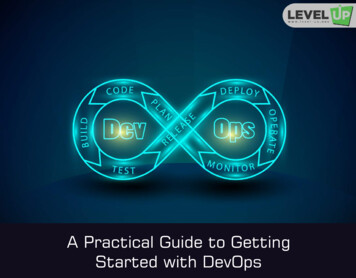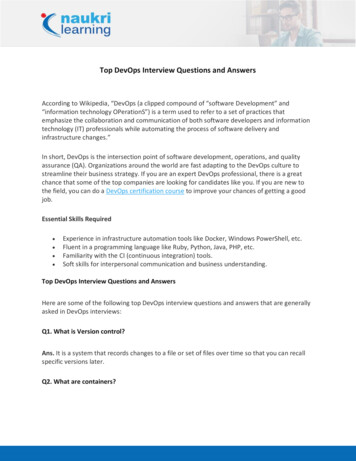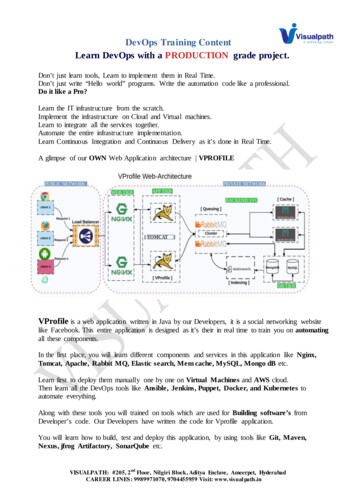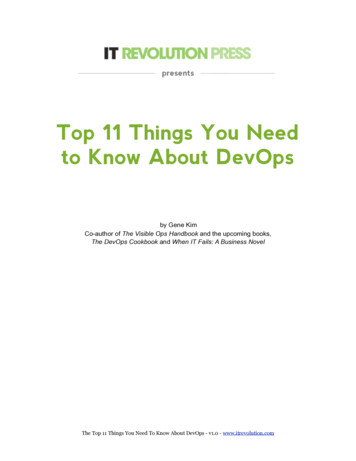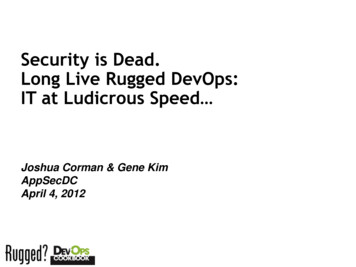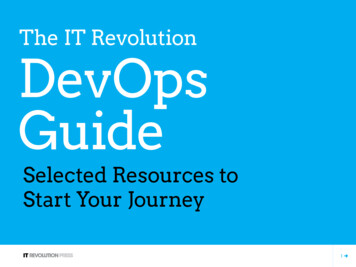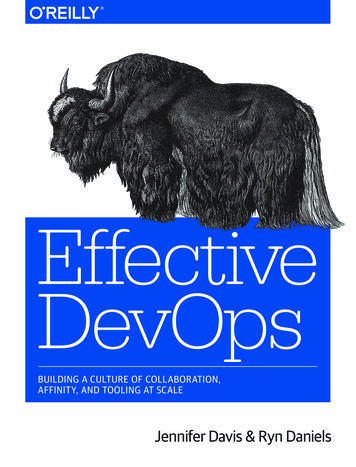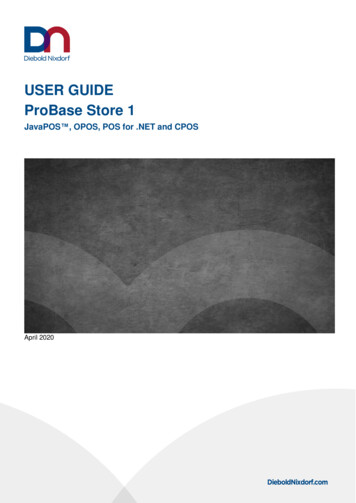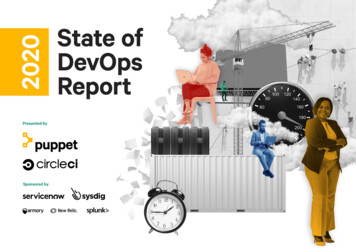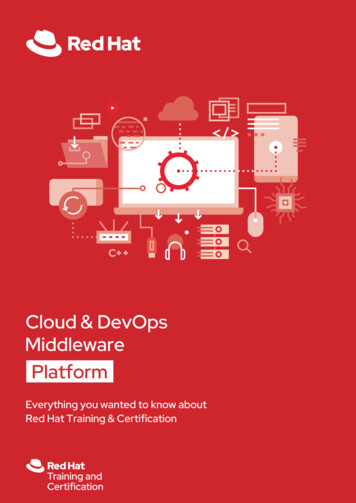
Transcription
Cloud & DevOpsMiddlewarePlatformEverything you wanted to know aboutRed Hat Training & Certification
Red Hat is the world’s leading provider of open source solutions, using acommunity-powered approach to provide reliable and high-performing cloud,virtualization, storage, Linux, and middleware technologies. Red Hat also offersaward-winning support, training, and consulting services. And as the connectivehub in a global network of enterprises, partners, and open source communities,Red Hat enables the creation of relevant, innovative technologies that liberateresources for growth and prepare customers for the future of IT. Red Hat is anS&P company with more than 85 offices spanning 35 countries across theglobe, empowering our customers' businesses. More than 90% of the Fortune500 use Red Hat Products and SolutionsRed Hat Enterprise Linux gives you the tools you need to modernize yourinfrastructure, boost efficiency through standardization and virtualization,and ultimately prepare your datacenter for an open, hybrid cloud ITarchitecture. Red Hat Enterprise Linux provides the stability to take ontoday's challenges and the flexibility to adapt to tomorrow's demands.
IndexCourseCodeCourse TitleDurationPage #RH124Red Hat System Administration I (RHEL 7 or 8)5 days4RH134Red Hat System Administration II (RHEL 7 or 8)4 days5RH199RHCSA Rapid Track Course (RHEL 7 or 8)4 days6RH236Red Hat Gluster Storage Administration3 days7RH254Red Hat System Administration III (RHEL 7)4 days8RH259Red Hat Enterprise Linux for SAP Solutions3 days9RH294Red Hat System Administration III:Linux Automation with Ansible 8)4 days10RH299RHCE Certification Lab (RHEL 7)4 days11RH318Red Hat Enterprise Virtualization4 days13RH342Red Hat Enterprise Linux Diagnosticsand Troubleshooting (RHEL 7)4 days14RH354Red Hat Enterprise Linux 8 New Featuresfor Experienced Linux Administrators3 days15RH362Red Hat Security: Identity Management andActive Directory Integration4 days16RH403Red Hat Satellite 6 Administration4 days17RH415Red Hat Server Hardening4 days19RH436Red Hat Enterprise Clustering andStorage Management4 days20RH442Red Hat Enterprise Performance Tuning (RHEL 7 or 8)4 days22
Duration: 5 daysRH124Red Hat System Administration I (RHEL 7 or 8)Part 1 of the core system administration tasks needed for Red Hat Enterprise LinuxThis course relates to Red Hat Enterprise Linux 7. Red Hat System Administration I (RH124) is designed for ITprofessionals without previous Linux administration experience. The course focuses on providing students with Linuxadministration "survival skills" by focusing on core administration tasks.Course overview:Red Hat System Administration I provides a foundation for students wishing to become full-time Linux systemadministrators by introducing key command line concepts and other enterprise-level tools. These concepts are furtherdeveloped in the follow-on course, Red Hat System Administration II (RH134).Prerequisites:There are no formal prerequisites for this course; however, previous operating system administration experience will bevery beneficial.Course contents:1.Access the command line2. Log in to a Linux system and run simple commandsusing the shell17. Configure and secure OpenSSH service18. Access and provide access to the command line onremote systems securely using OpenSSH3. Manage files from the command line19. Analyze and store logs4. Copy, move, create, delete, and organize files from20. Locate and accurately interpret relevant system logthe bash shell promptfiles for troubleshooting purposes5. Get help in Red Hat Enterprise Linux21. Manage Red Hat Enterprise Linux networking6. Resolve problems by using online help systems and22. Configure basic IPv4 networking on Red HatRed Hat support utilitiesEnterprise Linux systems7. Create, view, and edit text files23. Archive and copy files between systems8. Create, view, and edit text files from command output24. Archive files and copy them from one system toor in an editoranother9. Manage local Linux users and groups25. Install and update software packages10. Manage local Linux users and groups, and administer26. Download, install, update, and manage softwarelocal password policies11. Control access to files with Linux file systempermissions12. Set Linux file system permissions on files andpackages from Red Hat and yum package repositories27. Access Linux file systems28. Access and inspect existing file systems on a Red HatEnterprise Linux systeminterpret the security effects of different permission29. Use virtualized systemssettings30. Create and use Red Hat Enterprise Linux virtual13. Monitor and manage Linux processes14. Obtain information about the system, and controlprocesses running on it15. Control services and daemons16. Control and monitor network services and systemdaemons using systemmachines with KVM and libvirt31. Comprehensive review32. Practice and demonstrate the knowledge and skillslearned in this course
Duration: 4 daysRH134Red Hat System Administration II (RHEL 7 or 8)Part 2 of the core system administration tasks needed for Red Hat Enterprise LinuxThis course is specifically designed for students who have completed Red Hat System Administration I (RH124). Red HatSystem Administration II (RH134) focuses on the key tasks needed to become a full time Linux administrator.Course overview:This course goes deeper into enterprise Linux administration including file systems and partitioning, logical volumes,SELinux, firewalling, and troubleshooting. Attending both Red Hat System Administration I and Red Hat SystemAdministration II can help you in your preparation for the Red Hat Certified System Administrator exam (EX200).Prerequisites:Red Hat System Administration I (RH124)Course contents:1.Automate installation with Kickstart2. Automate the installation of Red Hat Enterprise Linuxsystems with Kickstart3. Use regular expressions with grep4. Write regular expressions that, when partnered with15. Connect to network-defined users and groups16. Configure systems to use central identitymanagement services17. Add disks, partitions, and file systems to a Linuxsystemgrep, will allow you to quickly isolate or locate content18. Manage simple partitions and file systemswithin text files19. Manage logical volume management (LVM) storage5. Create and Edit text files with vim20. Manage logical volumes from the command line6. Introduce the vim text editor, with which you can21. Access networked attached storage with network fileopen, edit, and save text filessystem (NFS)7. Schedule future Linux tasks22. Access (secure) NFS shares8. Schedule tasks to automatically execute in the future23. Access networked storage with SMB9. Manage priority of Linux processes24. Use autofs and the command line to mount and10. Influence the relative priorities at which Linuxprocesses run11. Control access to files with access control lists (ACL)unmount SMB file systems25. Control and troubleshoot the Red Hat EnterpriseLinux boot process12. Manage file security using POSIX access control lists.26. Limit network communication with firewall13. Manage SELinux security27. Configure a basic firewall14. Manage the Security Enhanced Linux (SELinux)28. Comprehensive reviewbehavior of a system to keep it secure in case of anetwork service compromise29. Practice and demonstrate knowledge and skillslearned in this course
Duration: 4 daysRH199RHCSA Rapid Track CourseCombines Red Hat System Administration I and II at a rapid paceThe RHCSA Rapid Track course (RH199) relates to Red Hat Enterprise Linux 7 and is designed for students who alreadyhave significant experience with Linux administration. The course reviews the tasks covered in Red Hat SystemAdministration I (RH124) and II (RH134) at an accelerated pace.Course overview:On completion of course materials, students should be prepared to take the Red Hat Certified System Administrator(RHCSA) exam.Prerequisites:Students for the class should have 1-3years of full time Linux administration experience.Course contents:1.Accessing the command line2. Log in to a Linux system and run simple commandsusing the shell3. Managing files from the command line4. Work with files from the bash shell prompt16. Control and monitor network services and systemdaemons using systemd17. Managing Red Hat Enterprise Linux networking18. Configure basic IPv4 networking on Red HatEnterprise Linux systems5. Managing local Linux users and groups19. Analyzing and storing logs6. Manage Linux users and groups and administer local20. Locate and interpret relevant system log files forpassword policies7. Controlling access to files with Linux file systempermissions8. Set access permissions on files and interpret thesecurity effects of different permission settings9. Managing SELinux security10. Use SELinux to manage access to files and interpretand troubleshoot SELinux security effects11. Monitoring and managing Linux processestroubleshooting purposes21. Managing storage and file systems22. Create and use disk partitions, logical volumes, filesystems, and swap spaces23. Scheduling system tasks24. Schedule recurring system tasks using cron andsystem timer units25. Mounting network file systems26. Mount network file system (NFS) exports and server12. Monitor and control processes running on the systemmessage block (SMB) shares from network file13. Installing and updating software packagesservers14. Download, install, update, and manage software27. Limiting network communication with firewalldpackages from Red Hat and yum package28. Configure a basic local firewallrepositories.29. Virtualization and kickstart15. Controlling services and daemons30. Manage KVMs and install them with Red HatEnterprise Linux using Kickstart
Duration: 3 daysRH236Red Hat Gluster Storage AdministrationDeploy scalable, highly available storage on off-the-shelf hardware and in cloud environmentsThis course is for senior system and storage administrators who are interested in deploying scalable, highly availablestorage on off-the-shelf hardware and in cloud environments. This course is based on Red Hat Gluster Storage 3.Course overview:Students will learn how to install, configure, and maintain a cluster of Red Hat Storage servers. The course will also explorehighly available common Internet file systems (CIFS) and network file systems (NFS) using Clustered Trivial DataBase(CTDB), unified file and object storage, and geo-replication. Finally, students will learn about the Hadoop plugin for RedHat Storage, snapshots, and geo-replication.This course can help you prepare for the Red Hat Certificate of Expertise in Hybrid Cloud Storage Exam (EX236).Prerequisites: Red Hat Certified System Administrator (RHCSA) certification or an equivalent level of knowledge is highlyrecommendedFor candidates who have not earned their RHCSA, confirmation of the needed skills can be obtained by passing the onlineskills assessment.Course contents:1.Introduction to Red Hat StorageUnderstand Red Hat Storage server features and9. Configure GeoreplicationConfigure georeplication for disaster recovery.terminology.10. Troubleshooting2. Install Red Hat Gluster StoragePerform basic troubleshooting tasks.Install Red Hat Gluster Storage.11. Manage Snapshots3. Configure Red Hat Gluster StorageManage volume snapshots.Build and configure a Red Hat Gluster Storagevolume.12. Install Red Hat Gluster Storage ConsoleInstall Red Hat Gluster Storage Console.4. Create VolumesCreate different volume types.13. Manage TieringManage storage tiering for a volume.5. Configure ClientsAccess data on Red Hat Gluster storage volumes withvarious clients.6. Configure ACLs and QuotasImplement POSIX ACLs and quotas.14. Monitor Red Hat Gluster StorageMonitor Red Hat Gluster Storage performance.15. Configure Network EncryptionConfigure Network Encryption for Red Hat GlusterStorage.7. Extend VolumesGrow storage volumes online.16. Comprehensive reviewPractice and demonstrate knowledge and skills8. Configure IP FailoverConfigure IP failover.learned in Red Hat Gluster Storage Administration.
Duration: 4 daysRH254Red Hat System Administration III (RHEL 7)Broaden your ability to administer Linux systems and prepare for your Red Hat Certified Engineer (RHCE) exam.Course overview:The course is focused on deploying and managing network servers running caching Domain Name Service (DNS),MariaDB, Apache HTTPD, Postfix SMTP nullclients, network file sharing with Network File System (NFS) and ServerMessage Block (SMB), iSCSI initiators and targets, advanced networking and firewalld configurations, and the use of Bashshell scripting to help automate, configure, and troubleshoot the system. Through lectures and hands-on labs, studentswho have already earned the RHCSA certification will be exposed to all competencies covered by the Red Hat CertifiedEngineer (RHCE) exam (EX300).Prerequisites:RHCSA certification or equivalent experience. For candidates who have not earned their RHCSA certification, confirmationof the correct skills and knowledge can be obtained by passing the online skills assessment.Course contents:1.Control services and daemons8. Provide file-based storageReview how to manage services and the boot-upProvide NFS exports and SMB file shares to specificprocess using systemctlsystems and users2. Manage IPv6 networkingConfigure and troubleshoot basic IPv6 networking onRed Hat Enterprise Linux systems3. Configure link aggregation and bridgingConfigure and troubleshoot advanced networkinterface functionality including bonding, teamingand local software bridges4. Control network port securityPermit and reject access to network services usingadvanced SELinux and firewalld filtering techniques5. Manage DNS for serversSet and verify correct DNS records for systems andconfigure secure DNS caching6. Configure email deliveryRelay all email sent by the system to an SMTPgateway for central delivery7. Provide block-based storageProvide and use networked iSCSI block devices asremote disks9. Configure MariaDB databasesProvide a MariaDB SQL database for use byprograms and database administrators10. Provide Apache HTTPD web serviceConfigure Apache HTTPD to provide Transport LayerSecurity (TLS)-enabled websites and virtual hosts11. Write Bash scriptsWrite simple shell scripts using Bash12. Bash conditionals and control structuresUse Bash conditionals and other control structures towrite more sophisticated shell commands and scripts13. Configure the shell environmentCustomize Bash startup and use environmentvariables, Bash aliases, and Bash functions14. Linux containers previewPreview the capabilities of Linux containers, Docker,and other related technologies in Red Hat EnterpriseLinux 715. Comprehensive reviewPractice and demonstrate knowledge and skillslearnedin Red Hat System Administration III
Duration: 3 daysRH259Red Hat Enterprise Linux for SAP SolutionsRed Hat Enterprise Linux for SAP Solutions (RH259) is designed to teach Linux administrators how to adapt Red Hat Enterprise Linux for the installation and operation of the in-memory database SAP HANA. This course discusses thesystem architecture with a focus on performance tuning and troubleshooting in order to meet the requirements of SAP.This course is based on Red Hat Enterprise Linux 7.4.Prerequisites:Be a Red Hat Certified System Administrator (RHCSA), or demonstrate equivalent experienceCourse contents:1.Get help in Red Hat Enterprise Linux7. Manage tuned profilesResolve problems using Red Hat support utilities andDeploy the automatic tuning daemon and createon-line systems.tuned profiles.2. Perform service management and boottroubleshootingControl and monitor system daemons and8. Limit resource usageConfigure POSIX resource limits and manage controlgroups.troubleshoot the Red Hat Enterprise Linux bootprocess.9. Understand storage profilingDescribe and use tools to generate a storage profile.3. Configure system tunablesLearn several methods to configure operating systemtuning parameters.4. Manage IPV4 networking reviewConfigure and troubleshoot basic IPv4 networking on10. Tune file systemsTune Linux filesystems for a database workload.11. Explore SAP HANA architectureUnderstand the core concepts of the SAP HANARed Hat Enterprise Linux systems.12. Learn Red Hat Enterprise Linux for SAP HANA5. Execute network teamingUnderstand the requirements of and how to installLearn how to configure 803.3ad network linkthe SAP HANA add-on for Red Hat Enterprise Linuxaggregation.and SAP HANA Express.6. Update software packages13. Consider Red Hat Enterprise Linux for SAP HANADownload, install, update, and manage softwaredeployment optionspackages from Red Hat and YUM packageLearn various ways to deploy Red Hat Enterpriserepositories.Linux for SAP HANA in the cloud or using Red Hat Satellite or Red Hat Ansible Automation.
Duration: 4 daysRH294Red Hat System Administration III: Linux Automation with Ansible (RHEL 8)Learn how to automate Linux system administration tasks with AnsibleRed Hat System Administration III: Linux Automation with Ansible (RH294) is designed for Linux system administratorsand developers who need to automate provisioning, configuration, application deployment, and orchestration. You willlearn how to install and configure Ansible on a management workstation; prepare managed hosts for automation; writeAnsible Playbooks to automate tasks; and run playbooks to ensure servers are correctly deployed and configured.This course is based on Red Hat Enterprise Linux 8 and Red Hat Ansible Engine 2.8.Course overview: Install Ansible / Red Hat Ansible Engine on control nodes. Create and update inventories of managed hosts and manage connections to them. Automate administration tasks with Ansible Playbooks and ad hoc commands. Write effective playbooks at scale. Protect sensitive data used by Ansible with Ansible Vault. Reuse code and simplify playbook development with Ansible roles.PrerequisitesPass the Red Hat Certified System Administrator (RHCSA) exam (EX200), or demonstrate equivalent Red Hat EnterpriseLinux knowledge and experienceCourse contents:1. Introduce AnsibleDescribe Ansible concepts and install Red Hat AnsibleEngine.2. Deploy AnsibleConfigure Ansible to manage hosts and run ad hocAnsible commands.3. Implement playbooksWrite a simple Ansible Playbook and run it toautomate tasks on multiple managed hosts.4. Manage variables and factsWrite playbooks that use variables to simplifymanagement of the playbook and facts to referenceinformation about managed hosts.5. Implement task controlManage task control, handlers, and task errors inAnsible Playbooks.6. Deploy files to managed hostsDeploy, manage, and adjust files on hosts managedby Ansible.7. Manage large projectsWrite playbooks that are optimized for larger, morecomplex projects.8. Simplify playbooks with rolesUse Ansible roles to develop playbooks more quicklyand to reuse Ansible code.9. Troubleshoot AnsibleTroubleshoot playbooks and managed hosts.10. Automate Linux administration tasksAutomate common Linux system administration taskswith Ansible.
Duration: 4 daysRH299RHCE Certification lab (RHEL 7)Prepare for the Red Hat Certified Engineer exam (EX300)The RHCE Certification lab (RH299) is designed for students seeking a hands-on, lab-based review prior to taking theRed Hat Certified Engineer (RHCE) exam. Students taking this course should have already completed their classroomtraining and simply be preparing to take or retake the exam.Course overview:During the 4-day course, students will work at their own pace through the complete set of labs from both the RHCSA (RedHat Certified System Administrator) Rapid Track course (RH199) and Red Hat System Administration III (RH254). TheRHCE Certification Lab course includes a few instructor lectures designed to review key technologies such as systemd,firewalld, and IPv6. For the classroom and virtual classroom versions of this course, an instructor will be availablethroughout the week to assist students as they work through the labs.Prerequisites:To qualify for this course, students must: Students should have already completed Red Hat System Administration I, II, and III or equivalent training It is highly recommended students take our online skills assessment prior to enrolling in this course Extensive UNIX administration experience by itself is not adequate for most studentsCourse contents:1.Local and remote logins7. Updating software packagesReview methods for accessing the system andDownload, install, update, and manage softwareengaging Red Hat Supportpackages from Red Hat and yum package repositories2. File system navigation8. Creating and mounting file systemsCopy, move, create, delete, link, and organize filesCreate and manage disks, partitions, and file systemswhile working from the Bash shell promptfrom the command line3. Users and groups9. Service management and boot troubleshootingManage Linux users and groups and administer localControl and monitor system daemons and troubleshootpassword policiesthe Red Hat Enterprise Linux boot process4. File permissions10. Network configurationControl access to files and directories usingConfigure basic IPv4 networking on Red Hatpermissions and access control lists (ACLs)Enterprise Linux systems5. SELinux permissions11. System logging and ntpManage the SELinux behavior of a system to keep itLocate and accurately interpret relevant system logsecure in case of a network service compromisefiles for troubleshooting purposes6. Process management12. Logical volume managementEvaluate and control processes running on a Red HatCreate and manage logical volumes from theEnterprise Linux systemcommand line
13. Scheduled processesSchedule tasks to automatically execute in the future21. Configuring E-mail DeliveryRelay all e-mail sent by the system to a SMTPgateway for central delivery14. Mounting network file systemsUse autofs and the command line to mount andunmount network storage with NFS and SMB22. Providing block-based storageProvide and use networked iSCSI block devices asremote disks15. Firewall configurationConfigure a basic firewall23. Providing file-based storageProvide NFS exports and SMB file shares to specific16. Virtualization and kickstartsystems and usersAutomate the installation of Red Hat Enterprise Linuxon virtual machines with kernel-based virtual machine(KVM) and libvirt24. Configuring MariaDB databasesProvide a MariaDB SQL database for use by programsand database administrators17. Managing IPv6 networkingConfigure and troubleshoot basic IPv6 networking onRed Hat Enterprise Linux systems25. Providing Apache HTTPD Web ServiceConfigure Apache HTTPD to provide Transport LayerSecurity (TLS)-enabled websites and virtual hosts18. Configuring link aggregation and bridgingConfigure and troubleshoot advanced networkinterface functionality including bonding, teaming,26. Writing Bash scriptsWrite simple shell scripts using Bashand local software bridges27. Bash conditionals and control structures19. Controlling network port securityPermit and reject access to network services usingUse Bash conditionals and other control structures towrite more sophisticated shell commands and scriptsadvanced SELinux and firewalld filtering techniques28. Configuring the shell environment20. Managing DNS for ServersSet and verify correct DNS records for systems andconfigure secure-caching DNSCustomize Bash startup and use environmentvariables, Bash aliases, and Bash functions
Duration: 4 daysRH318Red Hat Enterprise VirtualizationGet the skills required to deploy and manage virtual environmentsRed Hat Enterprise Virtualization (RH318) teaches experienced system administrators how to use the virtualizationfeatures of Red Hat Enterprise Linux managed through the Red Hat Enterprise Virtualization suite.Course overview:Students acquire the skills and knowledge to effectively create, deploy, manage, and migrate Linux and Microsoft Windowsvirtual machines hosted on either dedicated Red Hat Enterprise Virtualization Hypervisor nodes or Red Hat EnterpriseLinux servers using Red Hat Enterprise Virtualization Manager. With hands-on labs and a deep dive into the technology,this training course is the perfect first step for enterprise planning or executing a virtualization deployment strategy.This course also helps candidates prepare for the Red Hat Enterprise Virtualization Administrator exam (EX318), which, ifpassed, earns them the Red Hat Certified Virtualization Administrator (RHCVA) certification.Prerequisites: IT professionals who have earned an Red Hat Certified System Administrator (RHCSA) certification or maintain theequivalent experience with Linux System administration experience on Microsoft Windows operating systems is beneficial but not necessary for thiscourseCourse contents:1.Red Hat Enterprise Virtualization overview7. Virtual machine templatesUnderstand general virtualization, KVM concepts, andCreate Microsoft Windows and Red Hat EnterpriseRed Hat Enterprise Virtualization platformLinux virtual machines with template images2. Red Hat Enterprise Virtualization Manager8. Pools and usersInstall, test, remove, and troubleshoot Red HatUse pools and deploy the user portal with multilevelEnterprise Virtualization Manageradministrative roles3. Red Hat Enterprise Virtualization Hypervisor9. Monitoring and reportsInstall, configure, upgrade, and troubleshoot Red HatMonitor Red Hat Enterprise Virtualization and createEnterprise Virtualization Hypervisorcustom reports4. Red Hat Enterprise Virtualization environment10. Advanced Red Hat Enterprise VirtualizationconfigurationBack up and restore Red Hat Enterprise Virtualization;Create and configure datacenters, clusters, storageCLI and API interfacesdomains, and logical networks11. Red Hat Enterprise Linux hosts5. Red Hat Enterprise Virtualization for ServersManage virtual machines with Red Hat NetworkInstall, perform basic management of, andtroubleshoot virtual servers and images12. Migration and high availabilityMigrate a virtual machine and explore high availability6. Red Hat Enterprise Virtualization for DesktopsInstall virtual desktops and configure paravirtualizeddrivers.13. Comprehensive reviewApply the performance objectives learned throughoutthe course
Duration: 4 daysRH342Red Hat Enterprise Linux Diagnostics and Troubleshooting (RHEL 7)The Red Hat Enterprise Linux Diagnostics and Troubleshooting course (RH342) provides system administrators with thetools and techniques they need to successfully diagnose, and fix, a variety of potential issues. Students will work throughhands-on problems in various subsystems to diagnose and fix common issues.Course overview:Students will learn how to apply the scientific method to a structured form of troubleshooting. This approach is then usedtroubleshooting various types of problems, including boot issues, hardware issues, storage issues, RPM issues, networkissues, third-party application issues, security issues, and kernel issues. At the end of the course students can completevarious comprehensive review labs to test their skills.Prerequisites:Red Hat recommends these prerequisites: Have earned a Red Hat Certified System Administrator (RHCSA) or have similar experience It is recommended to students who have earned a Red Hat Certified Engineer (RHCE) or have similar experienceCourse contents:1.Introduction to troubleshootingDescribe a generalized strategy for troubleshooting.2. Take proactive steps to prevent small issuesPrevent small issues from becoming large problems7. Troubleshoot network issuesIdentify and resolve network connectivity issues.8. Troubleshoot application issuesDebug application issues.by employing proactive system administrationtechniques.9. Deal with security issuesIdentify and fix issues related to security subsystems.3. Troubleshoot boot issuesIdentify and resolve issues that can affect a system'sability to boot.10. Troubleshoot kernel issuesIdentify kernel issues and assist Red Hat Support inresolving kernel issues.4. Identify hardware issuesIdentify hardware problems that can affect a system'sability to operate.11. Red Hat Enterprise Linux Diagnostics andTroubleshooting comprehensive reviewPractice and demonstrate knowledge and skills5. Troubleshoot storage issuesIdentify and fix issues related to storage.6. Troubleshoot RPM issuesIdentify and fix problems in, and using, the packagemanagement subsystem.learned in Red Hat Enterprise Linux Diagnostics andTroubleshooting.
Duration: 3 daysRH354Red Hat Enterprise Linux 8 New Features for Experienced Linux AdministratorsPrepare yourself for Red Hat Enterprise Linux 8 by learning about changes to the operating systemRed Hat Enterprise Linux 8 New Features for Experienced Linux Administrators (RH354) introduces you to updates in theupcoming Red Hat Enterprise Linux release. Intended for experienced Linux system administrators, this course offers arapid orientation to Red Hat Enterprise Linux 8 based on the pre-release beta. The offering prepares operators, managers,principal system administrators, and other IT professionals with experience in Red Hat Enterprise Linux 7 for deploymentsand migrations to the new release.This course is based on Red Hat Enterprise Linux 8.Course overview: Install Red Hat Enterprise Linux 8 using the new packaging, modularity, and appstream features. Upgrade from Red Hat Enterprise Linux 7 to Red Hat Enterprise Linux 8 using new tools. Perform integrated file system and volume management using Stratis. Use Cockpit for system management. Create system images with Composer. Configure Identity Management using authselect. Understand the Wayland graphical display server. Deploy containers using the new integrated OCI runtime and tools. Configure firewall rules that use the new NFT back end.Prerequisites:Become a Red Hat Certified System Administrator (RHCSA), or demonstrate equivalent knowledge of and experience withRed Hat Enterprise Linux.Course contents:1.Preview Red
RH254 Red Hat System Administration III (RHEL 7) 4 days RH259 Red Hat Enterprise Linux for SAP Solutions 3 days RH294 Red Hat System Administration III: Linux Automation with Ansible 8) 4 days 10 RH299 RHCE Certification Lab (RHEL 7) 4 days 11 RH318 Red Hat Enterprise Virtualization 4 days 1

